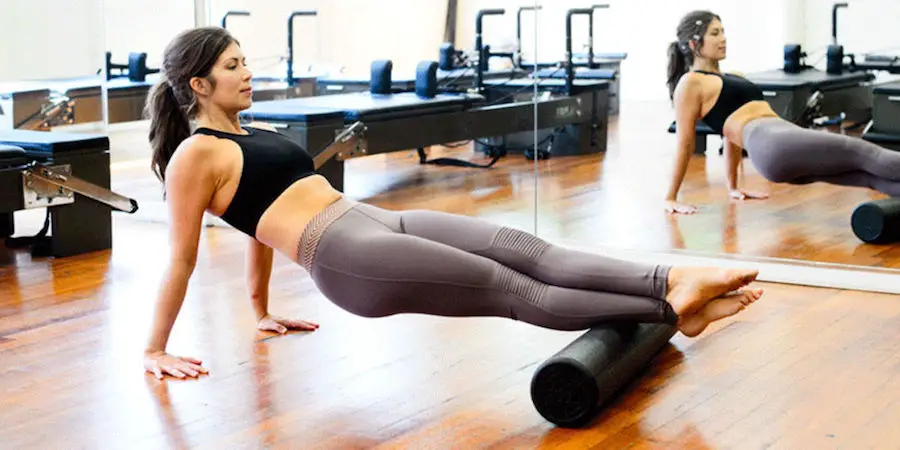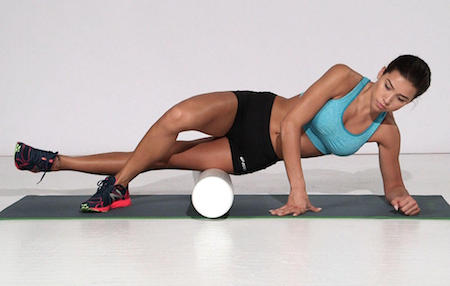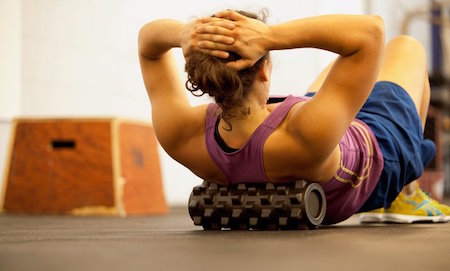Perhaps you’ve come across a stray foam roller in the gym only to wonder, “How do I use this?”. If you’ve ever taken certain fitness classes – especially strength training – you might be accustomed to using one.
Foam rolling is a fantastic tool to recovering after a brutal workout, but it’s not just limited to the gym! It’s an affordable piece to add to your home fitness collection, and can offer some fantastic therapeutic benefits daily, if you get in the habit of rolling it out.

Whether your muscles are sore or not, many of us spend too much time sitting, sleep in ways that hurt our backs or necks occasionally, or generally have some kinks we’d like to work out.
Massages and visits to the chiropractor are wonderful luxuries, but the bulk of us can’t afford the time or the money to do it everyday. Think of foam rolling as just that – a little massage therapy at home.
Not convinced? We’re not going to lie – foam rolling can hurt! Like a massage, the idea is to really get into the grooves and smooth things out. It’s the kind of pain that’s worth it, though, and here’s why.
Let’s talk recovery…

Consider that pain from exercise begins at a cellular level, essentially – in our muscle tissues. This study suggests that foam rolling is an effective way to both lessen inflammation in the tissue and deliver proper blood flow to the muscle tendons where blood flow is a little bit low.
Those who foam roll regularly are generally reporting less pain during and after workouts which is a good sign; while soreness is often worn as a ‘badge of honor’ after a heavy sweat session, it shouldn’t happen every time.
Without proper muscle treatment, we lose flexibility over time, movement becomes painful, blood flow is lost and our tissue suffers.
Myofascial release
This is the theory behind most of the benefits of foam rolling. Essentially, fascia is the “glue” of our bodies! It’s made up of collagen fibres, and it covers our whole body. It’s like our second skin.
Therefore, it takes quite a toll all the time as it’s exposed to the elements, and not just that – our movement makes an impact, and over time, the fascia is vulnerable.
When that fascia is covering our muscles (i.e. the connective tissue surrounding them), our muscles suffer too! As a result, our physical performance is affected and a whole lot of tension builds up.
The takeaway: When we discuss the benefits of foam rolling, we’re generally referring to the benefits of myofascial release, otherwise termed “self massage.”
Share this article on Pinterest
Improve your athletic performance

Static stretching is often seen as beneficial to your pre-workout routine, but those standard stretches can actually do more damage and stiffen up the body if done alone; think folding in half while standing or sitting on the ground.
Foam rolling is a very dynamic stretch, and it can both decrease muscle soreness and increase flexibility, leading to an awesome workout. A combination of both types of stretching can increase muscle output.
This study shows that the sit-and-reach range of motion was improved by foam rolling almost immediately. Flexibility is important – especially in the legs and hips – during weight training, yoga and more.
Preventing injury
Just as important as recovering after a workout is making sure you don’t have to recover any longer than a day or two. Ignored pain, poor form, bad pre- and post-workout care and a lack of dynamic stretching can end up putting you out of commission for way longer than needed, and nobody wants to be injured.
There’s nothing wrong with having a passion for training hard. Many runners – especially long-distance – will see benefits from consistent foam rolling which reduces inflammation. Exercise generally increases inflammation, so it’s all about finding that balance.
Reduction of DOMS (delayed onset muscle soreness)

DOMS typically occurs within 24-48 hours of a workout. It’s the soreness that you might associate with a job well done. While it can be reaffirming, being sore after every workout gets in the way of other workouts – especially the quality.
Besides, your body should grow quite accustomed to a routine over time, and you shouldn’t experience DOMS very often if your regime is working or you have enough variety (i.e. alternating working different muscle groups), contrary to popular belief.
DOMS is a sign of tissue damage and inflammation, both of which foam rolling and massaging are effective in treating.
How to foam roll
There are quite a few ways that you can start rolling it out. For one, you can use one of two devices: a long foam roller and/or a lacrosse ball – you can see the ball in use below.
The lacrosse ball can be used in smaller nooks and crannies including along the leg muscles (calves, quads and hamstrings), the muscles in the back, the glutes and more – think of it like fine-tuned foam rolling. Both methods will address the same things in the body – trigger points!
This is why foam rolling can be incredibly painful, and that’s how you know you’re doing it right. When you ‘roll’ those areas with a tension buildup, your body is going to tell you. It’s pretty intuitive, which makes it easier to get started.

Get into the groove
Here are some basic moves to get started with. You can essentially foam roll any muscle group that you can think of. The key is to apply moderate pressure and loosen the entire area. The initial pain should generally subside within 5-30 seconds depending on the amount of pressure and the amount of tension.
Remember – this is a muscle exercise, not a bone and joint exercise – avoid putting too much pressure on ’em! As a rule of thumb, you should also avoid rolling the lower back. Another key to successful and not-as-painful foam rolling is hydration, so drink up!
Upper back: Place the foam roller underneath your shoulders. Bend the knees with your feet flat on the ground, and raise your glutes from the floor. Keep the core tight and roll back and forth until the roller hits your mid-back.
Quads: Place the foam roller beneath the tops of the thighs, face-down, holding yourself up with your elbows bent and hands on the ground. Use the arms to roll the body back and forth with your feet in the air. Bring the roller up to the pelvic bone and back down along the quads.
Iliotobial band: This is a move for the runners! Refer to the photo above for where the IT band runs in the body. Place the roller beneath your IT band and use the corresponding arm to support your body. Move it up and down the leg using your arm to assist the motion.
Hamstrings and glutes: If you’d just like to activate the glutes, place the foam roller under the buttocks and use an angle to roll, assisting with both arms placed behind you. Take it down a little lower down the backs of the legs to get some hamstring massaging action underway. You can place your hands directly behind you for this, rather than at an angle.
Latissimus dorsi: This is your side, underneath where your arms lay when you’re standing straight up or laying down. Lie on either side with the corresponding arm straight up above your head, and place the foam roller under the armpit. Roll it to just above the waist.
The warmup is just as important as the cool down with foam rolling. A little bit of both is ideal. Share this with your gym partner, or tell us how you incorporate foam rolling into your fitness routine.
Music, mountains, dogs, travel, food and friends.


